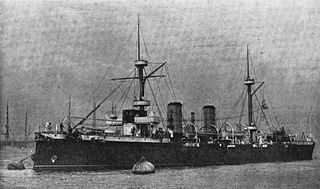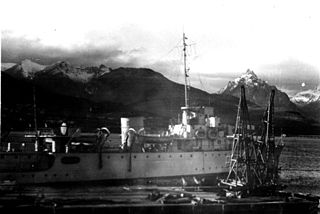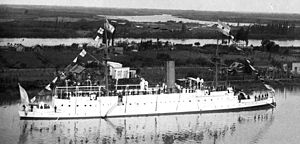
ARA La Argentina was a light cruiser, designed for training naval cadets, built for the Argentine Navy. The ship was authorised in 1934, and the contract was put out to tender in 1935, being won by the British company Vickers-Armstrongs at a cost of 6 million pesos.

ARA Garibaldi was one of four Giuseppe Garibaldi-class armored cruisers purchased by the Argentine Navy from Italy.

ARA San Martín was one of four Giuseppe Garibaldi-class armored cruisers purchased by the Argentine Navy from Italy.

Nueve de Julio was a protected cruiser of the Argentine Navy. The ship was acquired by the Argentine navy as part of the South American naval arms race in the 1890s. Completed in 1893, the vessel remained in service until 1930.

ARA Buenos Aires was a protected cruiser of the Argentine Navy. It was built by the British shipyard of Armstrong Mitchell and Co, being launched in 1895 and completing in 1896. Buenos Aires continued in use until 1932.

ARA Veinticinco de Mayo was a protected cruiser that served in the Argentine Navy between 1891 and 1921.

ARA Libertad was a battleship that served in the Argentine Navy between 1892 and 1947, and with the Argentine Coast Guard as a pilot station ship from 1947 to 1968. It was the seventh Argentine naval ship with this name.

ARA Independencia was a battleship that served in the Argentine Navy between 1893 and 1948, and with the Argentine Coast Guard as a pilot station ship from 1949 to 1968. It was one of nine Argentine naval ships bearing this name.

ARA King is a World War II-era Argentine Navy warship, originally classified as minelayer and later as patrol ship. The vessel is named after Juan King, an Argentine naval officer that served in the Cisplatine War. It is the third Argentine naval ship with this name.

ARA La Argentina was a steam corvette that served as a training ship with the Argentine Navy between 1884 and 1895, and in other roles until decommissioned in 1899.

ARA Azopardo is a World War II era Argentine Navy warship, originally classified as patrol boat and later as antisubmarine frigate. The vessel is named after Juan Bautista Azopardo, an Argentine naval officer that served in both the Argentine War of Independence and in the Cisplatine War. It is the third Argentine naval ship with this name.

ARA Piedra Buena is a World War II era Argentine Navy warship, originally classified as patrol boat and later as antisubmarine frigate. The vessel is named after Luis Piedrabuena, an Argentine mariner that explored and guarded Argentine sovereignty in Patagonia. It is the third Argentine naval ship with this name.

ARA Paraná was a steam and sail corvette built in United Kingdom in 1873 which served as a gunboat with the Argentine Navy between 1874 and 1899. It was decommissioned in 1900, converted to a transport and renamed Piedrabuena.
ARA Azopardo was a steam transport of the Argentine Navy, built in the Stabilimento Tecnico Triestino and sold to Argentina in 1884. It was based, among others, in the port of Buenos Aires and later Ushuaia, and was decommissioned in 1922 after being sunk in an accident; it was refloated and sunk in 1924 as a target. The vessel was named after the Juan Bautista Azopardo, a Maltese privateer and officer of the Argentine Navy during the Independence and Cisplatine wars, and was the first Argentine naval ship with this name.

The Murature-class patrol ships are a class of World War II era Argentine Navy warships, originally classified as minelayers and later reclassified as patrol ships. The class is named after José Luis Murature, Foreign Minister of Argentina from 1916 to 1918.

The Rosario-class gunboats were a class of two pre-World War I warships, designed and built in England in 1907–1909 as armoured riverine gunboats, to patrol the rivers Paraná and Uruguay. They were in service with the Argentine Navy from the late 1900s to the early 1950s. The lead ship of the class was named after Rosario, one of the major cities in Argentina.
ARA Ingeniero Julio Krause (B-13) was an oil tanker ship in service with the Argentine Navy from 1993 to 2015, and with YPF from to 1981 to 1993. She was the first ship in the Argentine Navy to bear the name of Argentine engineer Julio Krause, who discovered oil in Comodoro Rivadavia in 1907.
ARA Santa Cruz was an auxiliary ship of the Argentine Navy, built in the Fairfield Shipbuilding & Engineering Shipyard, Govan, Scotland, in 1921. She was transferred to the YPF tanker fleet after arrival in Argentina, and remained in YPF service until decommissioned and scrapped in 1948. The vessel was named after the Argentine province of Santa Cruz, and is the ninth Argentine naval ship with this name.















